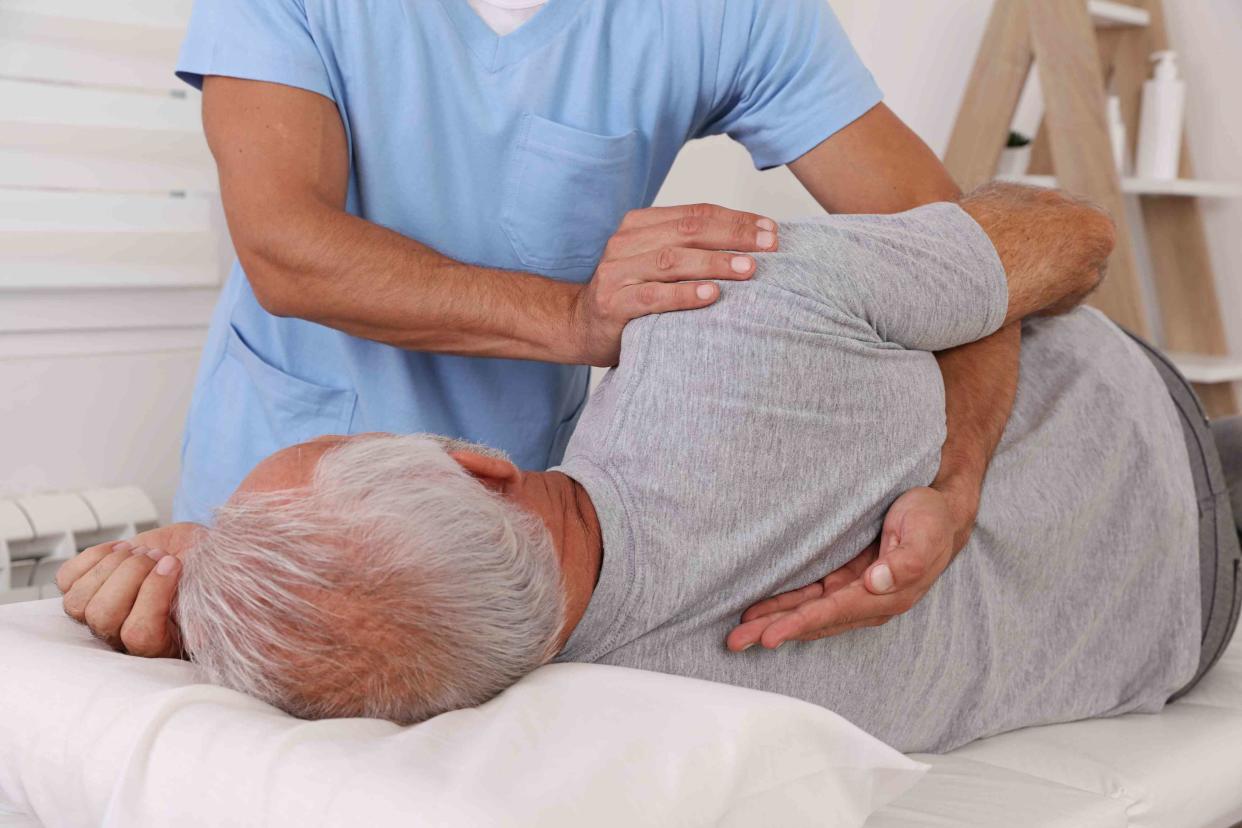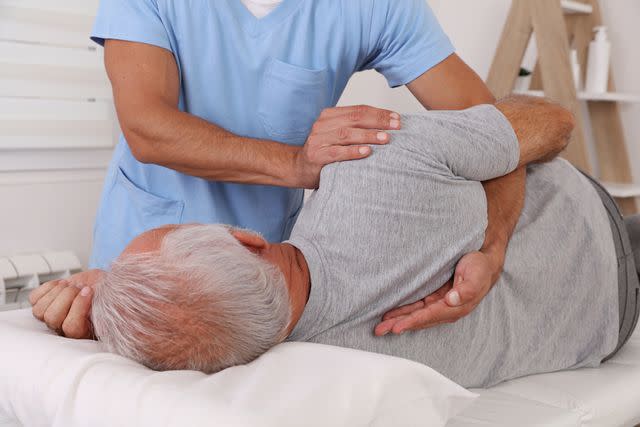Disc Desiccation: Treatment and Support for Aging Bodies

Albina Gavrilovic / Getty Images
Medically reviewed by Oluseun Olufade, MD
Disc desiccation (also known as spinal disc dehydration) can be part of aging or degenerative disc disease. Neck pain can signal cervical disc degeneration, whereas low-back pain signals a lower lumbar disc degeneration.
Whether you have disc desiccation due to disease or the natural process of wear-and-tear caused by aging, there are medical, complementary, and holistic approaches to treating and coping with disc desiccation.
This article will detail disc desiccation diagnosis, its causes, how to tell the difference between mild and severe disc desiccation, and what treatment and recovery options may be available.

Albina Gavrilovic / Getty Images
How Do You Know You Have Disc Desiccation?
Spinal discs are the spongy space holders in between vertebrae (bones of the spine) that make up your spinal column. These discs help absorb shock when moving and keep your spine safe. You may not know you have disc desiccation since symptoms are not always present, especially in the early stages. Experts say in most people, pain symptoms are not present until the condition progresses to a severe stage.
Where Does Disc Desiccation Occur?
Disc desiccation can occur in the following areas:
Lumbar desiccation: Lower back
Cervical desiccation: Upper back and neck
If you have pain in the neck or back, consider consulting with your healthcare provider. At this stage, the disc desiccation is likely to be detectable on an X-ray, and an official diagnosis can be made. Computed tomography (CT) scans and magnetic resonance imaging (MRI) scans can be even more helpful in these cases. MRIs can provide information on the water content in the discs, for example.
Testing and Diagnosis
For people with multiple degenerated discs and more widespread pain in the area, more testing options may be suggested to get a better sense of the source of the issue. Undergoing a CT or with dye injected into the discs may help reveal the source of pain.
Aging, Disc Desiccation, and Other Disc Stressors
There are many reasons why someone may end up experiencing disc desiccation or degeneration. For example, "degeneration" is a word describing the process of aging. This means some disc desiccation as you age is expected. Disc desiccation cannot be reversed naturally, but it can be slowed and it can be remedied by treatment.
The causes of disc desiccation include:
Aging or wear-and-tear
Injury, fall, or other trauma to the spine
Repeat back strain or physical stress (i.e., from repeatedly lifting heavy objects or bending and lifting)
Poor posture
Sedentary lifestyle
Ankylosing spondylitis (an autoimmune disease and form of arthritis causing severe inflammation leading to spinal disc fusion over time)
Back injury and disc desiccation can occur together. A 2018 study suggests 12% of people under 50 years of age presenting with back trauma also experience significant disc desiccation.
Symptoms: Mild to Severe Disc Desiccation
Symptoms of disc desiccation range from mild to severe. In mild cases, you may not feel any pain. As the disc presses on surrounding nerves and pain progresses or spreads, the condition is becoming more severe.
However, this is an oversimplification. Some people may experience pain in early disc desiccation while others may not experience symptoms until after much more degeneration has occurred. Some patients find that pain decreases over time. This is why diagnosis based on pain alone is not possible.
Symptoms to watch for include:
Stiffness in the neck or back
Weakness
Tingling
Loss of height
When Is Disc Desiccation Severe?
If you have disc desiccation and it worsens from mild to severe, you may experience pain traveling from the localized area of your neck or lower back down your legs and to your feet. Severe disc desiccation can cause nerve compression, muscle spasms, spinal instability, and structural changes.
Different Treatment Approaches for Disc Desiccation
You may be wondering if you can heal or rehydrate disc desiccation. There are many treatment approaches for pain and other symptoms, including nerve compression. Here are the most common approaches to treating disc desiccation.
Noninvasive and nonsurgical approaches include:
Pain-relieving medications such as nonsteroidal anti-inflammatories or NSAIDs to help reduce pain
Physical therapy to help strengthen core muscles which provide support to the spine
Massage therapy to help relieve pressure in the area
Spinal Injections
For more severe cases of disc desiccation, spinal injections or facet joint injections are the likely next step. Spinal injections deliver steroids with pain-relieving medication straight to the source and can offer longer-lasting pain relief. They do not cure disc desiccation.
Surgical Options
Spinal fusion surgery is the most aggressive option. Spinal fusion surgery is when a surgeon fuses vertebrae together so they will no longer rub against each other in the absence of a hydrated disc. This form of invasive treatment will only be used when other options have not provided adequate or lasting relief.
Spinal surgery can also be used to remove discs, remedy abnormal disc structures causing pain, and add spacers, artificial discs, or nerve stimulators between the vertebrae.
Read Next: Primary and Secondary Chronic Pain Classifications
Making Adjustments Around Disc Desiccation Pain
Living with disc desiccation pain can be challenging, but there are adjustments you can make. Experts advise avoiding activities that contribute to pain.
Expert suggestions include:
Kneeling or reclining instead of sitting
Avoiding lifting in bent positions
Wearing a corset brace or cervical collar to provide support
Related: How Obesity Is Treated
Exercise and Stretches for Disc Desiccation
It's never too late to start exercising and stretching for disc desiccation. If you already know you have disc desiccation, consult with your healthcare provider on what may be best for you. The following activities and stretches generally are suitable but should be run by your provider before starting:
Pilates
Swimming
Other core-strengthening activities
Gentle stretching
Related: What Is Chronic Pain?
Chronic Disc Desiccation: Daily Management and Self-Care
Daily management and self-care when living with chronic pain may be overwhelming and feel restrictive. For example, you may be grieving the loss of mobility or grieving the loss of certain activities and career opportunities. You're not alone in these feelings. Taking steps to manage how you cope with chronic pain is always worthwhile.
If you're unsure of where to begin, speaking with your healthcare provider or a mental health professional can be a great first step.
Here are some other expert tips for daily management and self-care that can help slow down degeneration when you have disc desiccation:
Consume a healthy diet complete with enough water to prevent dehydration.
Maintain a healthy weight for your body type to prevent unnecessary pressure on discs.
Avoid or quit smoking which speeds up disc dehydration.
Moderate or avoid alcohol which contributes to disc dehydration.
Read Next: How Occupational Therapists Can Improve Your Life With Yoga
Summary
Disc desiccation is spinal disc dehydration. It is caused by aging but also by injury, trauma, and ankylosing spondylitis. Symptoms are not always obvious, but when they are, they include pain, weakness, and stiffness, and can lead to nerve compression and traveling pain down the legs.
Treatments include non-surgical options like taking pain-relieving medications or participating in physical therapy. However, more aggressive treatment methods exist such as spinal injections for pain and inflammation and spinal fusion surgery in severe cases. Other ways of managing pain include avoiding activities that contribute to pain or desiccation and maintaining a healthy lifestyle.

